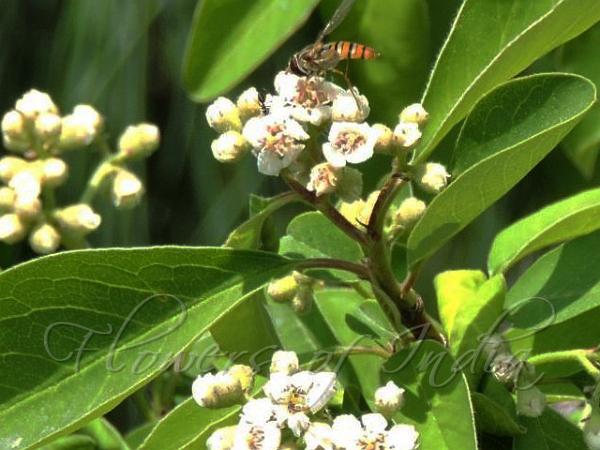|
| Purpleberry Cotoneaster |
|

|

|
|
|
|
Photo: |
Botanical name: Cotoneaster affinis Family: Rosaceae (Rose family)
Synonyms: Cotoneaster bacillaris, Cotoneaster confusus, Cotoneaster parvifolius
Synonyms: Cotoneaster bacillaris, Cotoneaster confusus, Cotoneaster parvifolius
Purpleberry Cotoneaster is a deciduous shrub, up to 5
m tall. Flowers are borne in compound corymbs 3-4 cm across,
15-30-flowered or more. Axis and flower-stalks are densely yellow
woolly; bracts linear-lanceshaped, woolly. Flower-stalks are 2-3 mm,
flowers about 1 cm in diameter. Sepal-cup is bell-shaped, below woolly.
Sepals are broadly triangular, tip pointed. Petals are spreading,
white, nearly round or ovate, 3-4 mm, above velvet-hairy near base,
base shortly clawed, tip blunt. Stamens are 20, shorter than sepals.
Branchlets are dark reddish brown, round. Leaf-stalks are 4-5 mm,
densely yellow woolly; stipules linear or lanceshaped. Leaves are ovate
or elliptic-ovate, 2.5-5 x 1.4-2 cm, midvein raised below and impressed
above, below densely yellow woolly, gradually becoming hairless, base
broadly wedge-shaped, tip blunt or pointed. Fruit is purplish brown to
black, ovoid, 6-8 mm in diameter. Purpleberry Cotoneaster is found on
slopes, mixed forests, thickets of river valleys in the Himalayas, from
Kashmir to Bhutan, SE Tibet, W. China, at altitudes of 1100-2800 m. It
is commonly used for making walking sticks and for controlling cattle.
Flowering: May-June.
| Identification credit: Anil Thakur | Photographed in Shimla, Himachal Pradesh & Mussoorie, Uttrakhand. |
• Is this flower misidentified? If yes,